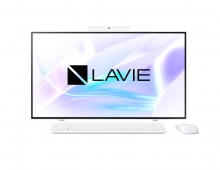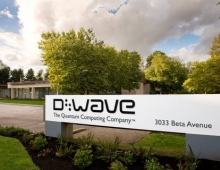NEC ND-3520A full review
2. Transfer Rate Reading Tests
Review Pages
2. Transfer Rate Reading Tests
3. CD Error Correction Tests
4. DVD Error Correction Tests
5. Protected Disc Tests
6. DAE Tests
7. Protected AudioCDs
8. CD Recording Tests
9. Writing Quality Tests - 3T Jitter Tests
10. Writing Quality Tests - C1 / C2 Error Measurements
11. Writing Quality Tests - Clover System Tests
12. DVD Recording Tests
13. Media Support list - +R/+RW/+R9 (DL) media
14. Media Support list - -R/-RW
15. Media Support list - CD-R/CD-RW
16. CDSpeed/PlexTools Scans - Page 1
17. CDSpeed/PlexTools Scans - Page 2
18. CDSpeed/PlexTools Scans - Page 3
19. CDSpeed/PlexTools Scans - Page 4
20. CDSpeed/PlexTools Scans - Page 5
21. CDSpeed/PlexTools Scans - Page 6
22. CDSpeed/PlexTools Scans - Page 7
23. CDSpeed/PlexTools Scans - Page 8
24. CDSpeed/PlexTools Scans - Page 9
25. DVD+R DL - Page 1
26. DVD+R DL - Page 2
27. BookType Setting
28. Conclusion
NEC ND-3520A Burner - Page 2
Transfer Rate Reading Tests
- CD Format
The CD reading speed is not changed from the ND-3500A and is tuned up to 48X. Below are the transfer rate graphs along with the comparative results for the Plextor PX-716A and the Toshiba SD-R5372 drives:
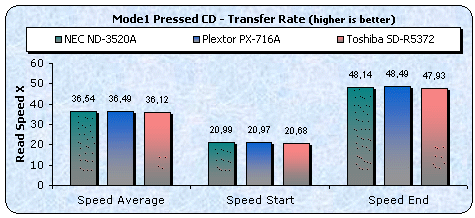
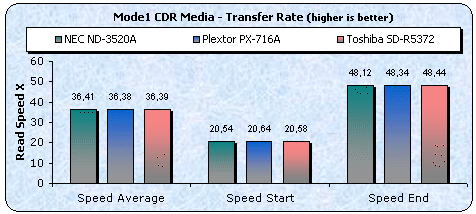
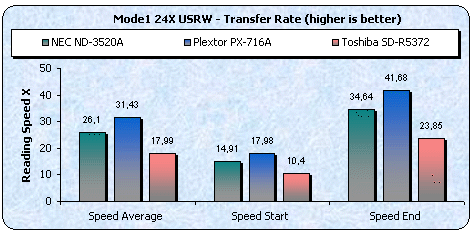
The performance matrix indicates more or less the same behaviour for all drives except in the RW transfer where the Plextor drive managed to outperform the NEC drive with Ultra-Speed CD-RW media and the Toshiba burner being the slowest.
- DVD Format
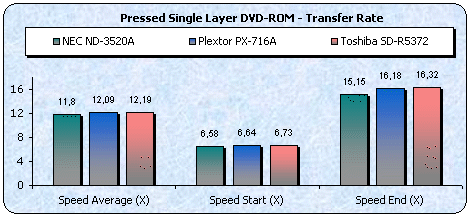
Although the NEC ND-3520A was the slowest among the three burners, the differences was marginal.

The two layers of a PTP DVD-ROM disc are read sequentially with the drive starting reading from the inner part of the disc, which is the beginning of each layer, progressing towards the outer range for each layer. With pressed PTP dual layer media, the ND-3520A was the slowest among the drives, while the Plextor burner was the fastest again and with a large difference.

The first layer of an OTP dual layer DVD-ROM is read exactly the same way as the first layer of the PTP disc we tested previously. The difference here is the reading strategy of the second layer on the disc. The beginning of the second layer is located in the outer part of the disc, so the drive starts reading from the outer tracks towards the inner part of the disc. Same picture here with the NEC drive being the slowest and Plextor burner again way in front.
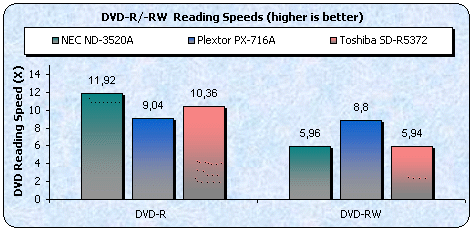

The NEC ND-3520A seems to take its revenge with DVD-R and DVD+R media. It reported 11.92X and 11.91X average reading speeds respectively. ReWritable media reading speeds however, were slowest, slightly behind the Toshiba SD-R5372 and a good deal behind the Plextor.
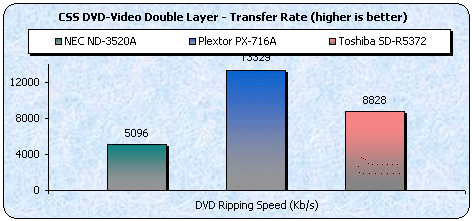
DVD-Video ripping speed was never a strong point of NEC drives, since NEC uses a so called "Rip-Lock" to reduce the maximum ripping speed allowed by the burner, to ensure safer reading performance. The ND-3520A drive reported an average speed of 5096kb/sec while the Plextor burner was more than twice as fast. On the other hand, the ripping speed of Plextor PX-716A cannot be surpaased by any burner currently available on the market.
-Appendix
Nero CD-DVD Speed Graphs
- CD Pressed / CD-R / US-RW
- DVD Pressed SL / DVD Pressed DL / DVD-R / DVD-RW / DVD+R / DVD+RW
Review Pages
2. Transfer Rate Reading Tests
3. CD Error Correction Tests
4. DVD Error Correction Tests
5. Protected Disc Tests
6. DAE Tests
7. Protected AudioCDs
8. CD Recording Tests
9. Writing Quality Tests - 3T Jitter Tests
10. Writing Quality Tests - C1 / C2 Error Measurements
11. Writing Quality Tests - Clover System Tests
12. DVD Recording Tests
13. Media Support list - +R/+RW/+R9 (DL) media
14. Media Support list - -R/-RW
15. Media Support list - CD-R/CD-RW
16. CDSpeed/PlexTools Scans - Page 1
17. CDSpeed/PlexTools Scans - Page 2
18. CDSpeed/PlexTools Scans - Page 3
19. CDSpeed/PlexTools Scans - Page 4
20. CDSpeed/PlexTools Scans - Page 5
21. CDSpeed/PlexTools Scans - Page 6
22. CDSpeed/PlexTools Scans - Page 7
23. CDSpeed/PlexTools Scans - Page 8
24. CDSpeed/PlexTools Scans - Page 9
25. DVD+R DL - Page 1
26. DVD+R DL - Page 2
27. BookType Setting
28. Conclusion




